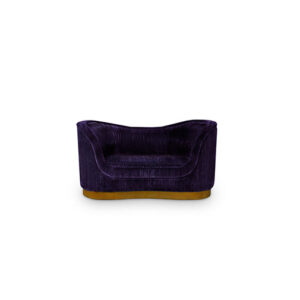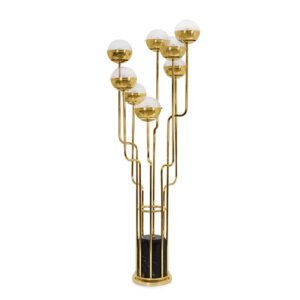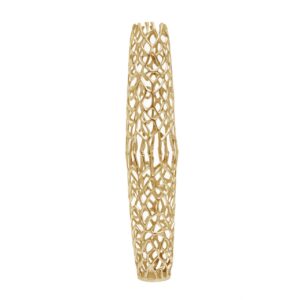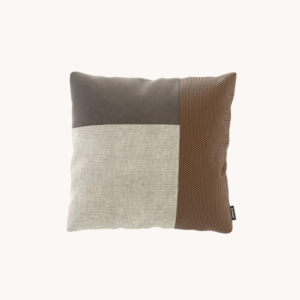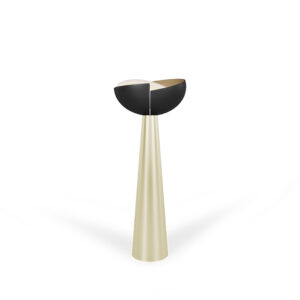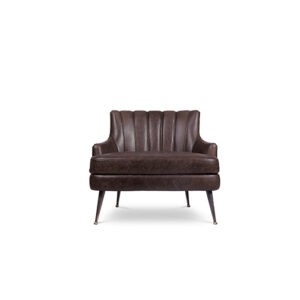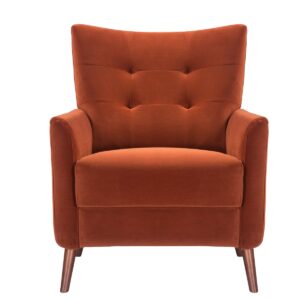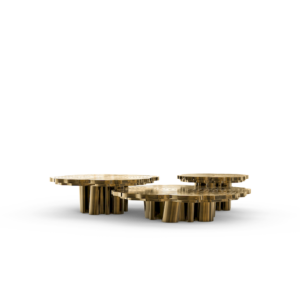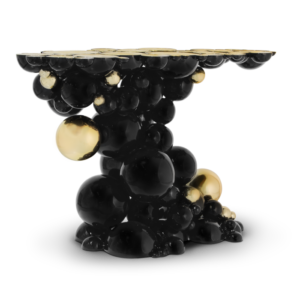Inspiration
EMBRACING THE OPULENCE IN MAXIMALISM DECOR
Unveil Luxury, Unleash Comfort – Eclectic Niche.
Maximalism in décor is an expressive and bold design style that celebrates abundance, eclecticism, and personal expression. Unlike minimalism décor, which focuses on simplicity and restraint, maximalism décor revels in excess, embracing vibrant colours, intricate patterns, and a diverse range of textures. As minimalism gained popularity in the late 20th and early 21st centuries, with its emphasis on clean lines, neutral colours, and decluttered spaces, some individuals began to seek alternatives that allowed for more self-expression and personality in their homes. Maximalism emerged as a counterpoint to the starkness of minimalism, offering a bold and vibrant alternative that celebrates individuality and creativity. Rather than adhering to strict rules of simplicity and restraint, maximalism encourages the use of bold colours, intricate patterns, and diverse textures to create visually stimulating and highly personalized interiors.
In this sense, maximalism décor can be seen as a reaction against the perceived limitations of minimalism décor, providing a design philosophy that allows for greater freedom, expression, and indulgence in the home. It offers a refreshing departure from the less-is-more mentality, inviting people to embrace the richness and complexity of life through their surroundings.
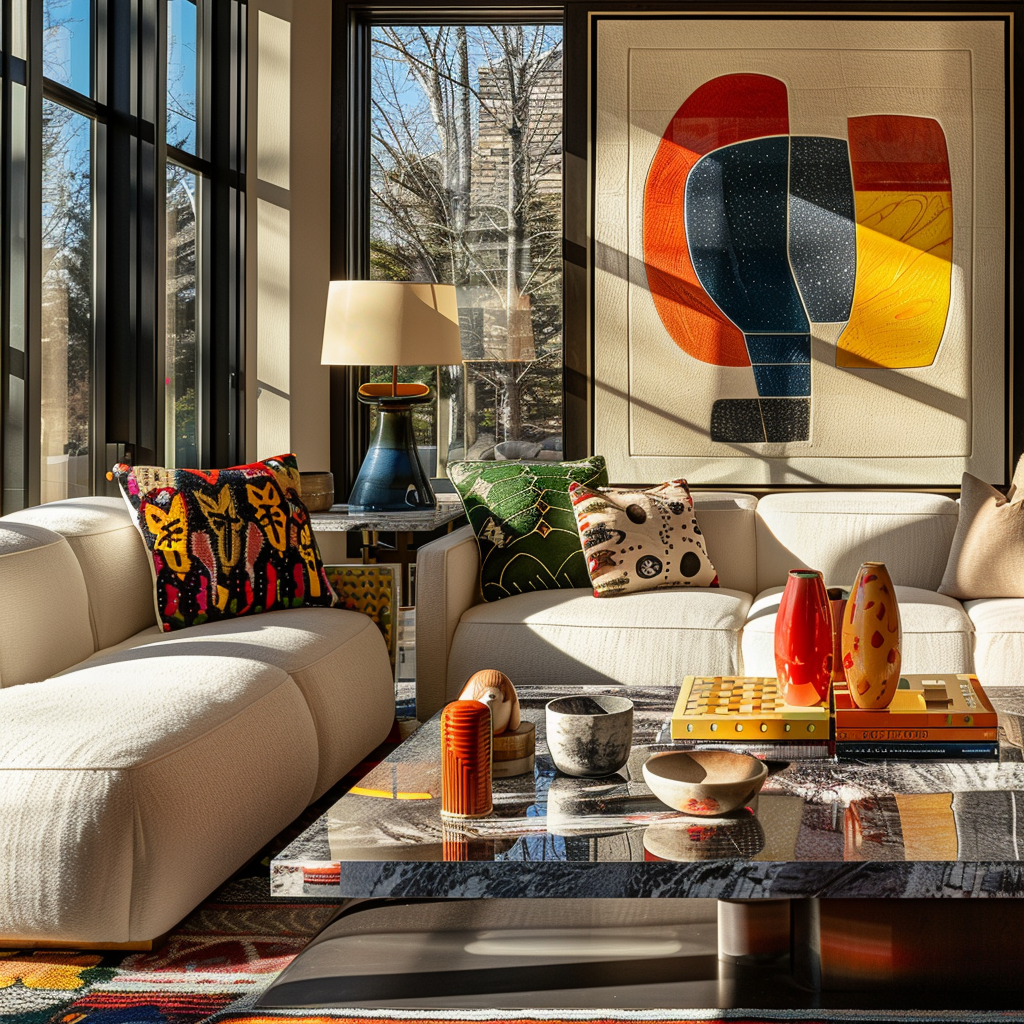
Rise of Maximalism
Maximalism has experienced a notable resurgence in recent years, emerging as a compelling alternative to the dominance of minimalism in the design world. While minimalism gained popularity in the late 20th and early 21st centuries for its clean lines, neutral colors, and decluttered spaces, some individuals began to seek alternatives that allowed for more self-expression and personality in their homes. This led to a renewed interest in maximalism, which offers a bold and vibrant aesthetic characterized by opulence, drama, and indulgence. Today, maximalism continues to captivate designers and homeowners alike, inspiring them to embrace creativity, color, and individuality in their living spaces.
Contrasting Maximalism with Minimalism Decor
Maximalism and minimalism stand at opposite ends of the design spectrum, each offering a unique approach to decorating living spaces.
Minimalism, characterized by its emphasis on simplicity and austerity, advocates for a less-is-more philosophy. It favors clean lines, neutral color palettes, and sparse furnishings to create serene and uncluttered environments. Minimalist spaces often exude a sense of calm and tranquility, with every element carefully curated for its functionality and visual impact.
In stark contrast, maximalism embraces an ethos of abundance, extravagance, and self-expression. Rather than adhering to the principles of restraint and moderation, maximalist decor celebrates opulence in all its forms. It revels in vibrant colors, bold patterns, and luxurious textures, creating spaces that are richly layered and visually dynamic. Maximalist interiors are eclectic, reflecting the diverse tastes and personalities of their inhabitants.
-

Brabbu
DAKOTA SINGLE SOFA
£6,682 – £9,672 Select options This product has multiple variants. The options may be chosen on the product page -

Brabbu
NIKU FLOOR LIGHT
£6,751 Add to cart -

North West
Prato Large Vase
£162 Add to cart
Celebrating Abundance, Eclecticism, and Personal Expression
At the heart of maximalism decor lies the celebration of abundance, eclecticism, and personal expression. Unlike minimalist spaces, which prioritize uniformity and simplicity, maximalist interiors are characterized by their diversity and complexity.
Abundance: Maximalist decor is defined by its lavishness and extravagance. Rooms are often filled with layers of furniture, accessories, and decor items, creating a sense of opulence and grandeur. Rather than adhering to the notion of “less is more,” maximalism embraces the idea that “more is more,” resulting in spaces that feel sumptuous and indulgent.
Eclecticism: Eclecticism is a hallmark of maximalist decor, allowing for the seamless integration of various styles, periods, and cultural influences. Maximalist interiors are a melting pot of design elements, where mid-century modern furniture coexists with antique Persian rugs, and contemporary artwork shares space with global accents. This eclectic mix of styles and influences adds depth and character to maximalist spaces, making them visually intriguing and highly personalized.
Personal Expression: Maximalism decor provides a canvas for self-expression and individuality, allowing homeowners to showcase their personalities and tastes through their living spaces. Whether it’s through bold colors, quirky accessories, or cherished collections, maximalist interiors serve as reflections of the people who inhabit them. Each room becomes a storytelling opportunity, filled with meaningful objects and mementos that tell the story of its occupants.
In summary, maximalism decor is a bold and expressive design style that celebrates the beauty of abundance, eclecticism, and personal expression. By contrasting it with minimalism and emphasizing its key principles, we gain a deeper understanding of what makes maximalism such a compelling and captivating design trend.
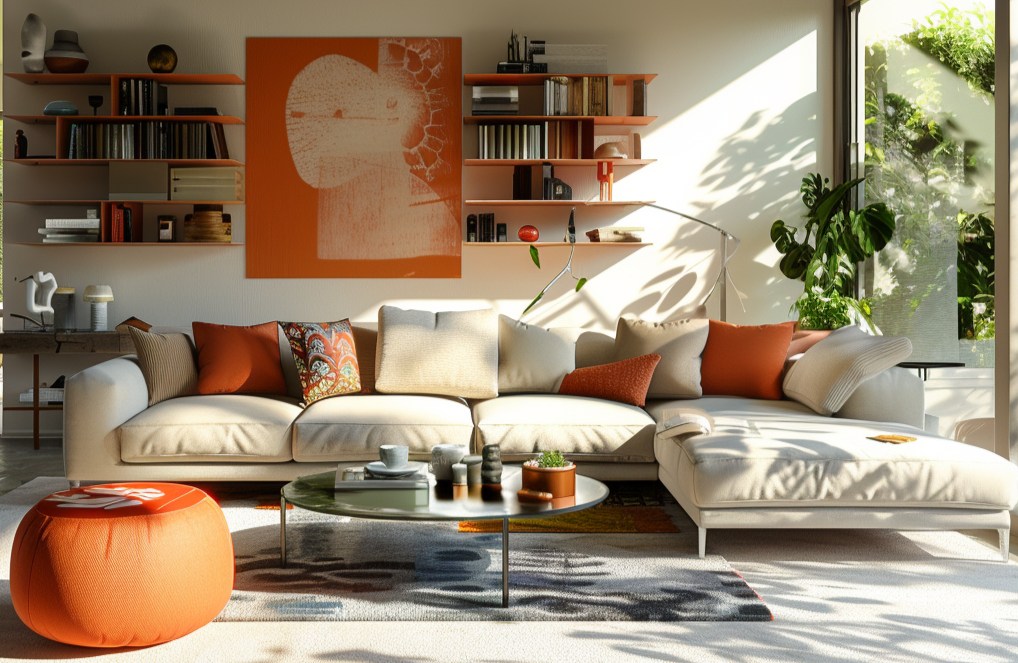
Historical Context and Evolution of Maximalism
Maximalism, in its essence, is a celebration of abundance, a departure from the minimalist trends that dominated much of the late 20th and early 21st centuries. However, to truly appreciate maximalism, one must delve into its historical roots, understanding how it emerged as a response to prevailing design philosophies.
Historical Roots: Maximalism finds its origins in various artistic movements throughout history. From the ornate Baroque and Rococo periods to the eclectic styles of the Victorian era, there has always been a fascination with opulence and grandeur in design. These historical influences laid the groundwork for maximalism, emphasizing lavishness, intricate details, and the use of diverse materials.
Evolution Over Time: While maximalism has its roots in historical design movements, its modern incarnation has evolved significantly. In the mid to late 20th century, minimalism gained traction, with its focus on simplicity, clean lines, and a pared-down aesthetic. However, as with any design trend, there was a natural pendulum swing back towards maximalism.
Postmodern Influence: The postmodern movement of the late 20th century challenged the austerity of minimalism, advocating for a more playful and eclectic approach to design. This period saw a resurgence of interest in historical ornamentation, cultural references, and bold aesthetics, laying the foundation for the maximalist resurgence.
Contemporary Interpretations: In the contemporary design landscape, maximalism has taken on new forms, influenced by global cultures, technological advancements, and shifting societal values. Today, maximalism is not just about excess; it’s about personal expression, creativity, and embracing the diversity of the human experience.
Fundamental Principles of Maximalism Décor
1. Abundance: Maximalism décor is characterized by its abundance of visual elements. Rooms are often filled with layers of furniture, accessories, and decor items, creating a rich and luxurious atmosphere. Rather than adhering to the notion of “less is more,” maximalism embraces the idea that “more is more,” resulting in spaces that feel opulent and indulgent.
2. Eclecticism: Eclecticism is a design approach or philosophy that involves combining elements from various styles, periods, or cultural influences to create a cohesive and unique aesthetic. Rather than adhering strictly to one particular style or tradition, eclecticism embraces diversity and creativity, allowing for the integration of different design elements in a harmonious way. In interior design, eclecticism often manifests as a mix of furniture, décor, and architectural details sourced from different time periods, regions, or design movements. For example, a room may feature a blend of mid-century modern furniture, antique Persian rugs, contemporary artwork, and global accents, all seamlessly integrated to create an eclectic yet cohesive space.
Eclecticism encourages freedom of expression and personalization, as individuals are free to curate spaces that reflect their own tastes, interests, and experiences. It celebrates the beauty of diversity and the richness of cultural exchange, resulting in interiors that are vibrant, dynamic, and full of character.
3. Personal Expression: At its core, maximalism décor is about self-expression and individuality. Maximalist spaces often serve as reflections of the personalities and lifestyles of their inhabitants. Whether it’s through bold colours, quirky accessories, or cherished collections, maximalism provides a canvas for people to showcase their passions and experiences. Each room becomes a storytelling opportunity, filled with meaningful objects and memories.
4. Layering: Layering is a key technique in maximalism décor, used to create depth, texture, and visual interest. This involves combining different elements such as rugs, textiles, artwork, and decorative objects to build up the overall look of a room. By layering various patterns, colours, and textures, maximalist spaces achieve a sense of complexity and dimension that captivates the eye.
5. Boldness and Drama: Maximalism décor is unapologetically bold and dramatic. It embraces vibrant hues, intricate patterns, and eye-catching details to make a statement. From oversized artwork to ornate chandeliers, maximalist interiors are designed to command attention and evoke emotions. The goal is to create spaces that feel lively, dynamic, and full of energy.
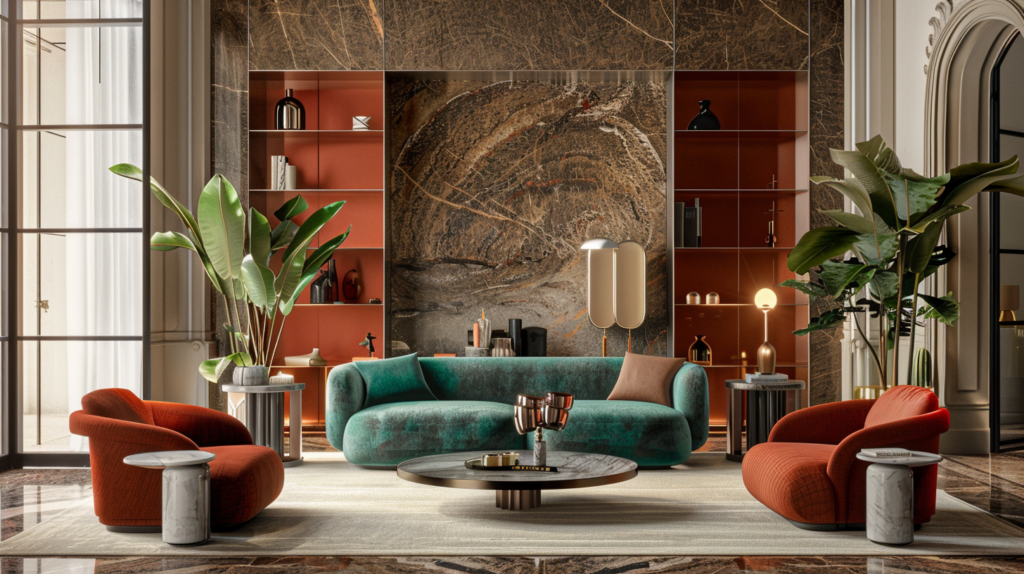
Embracing Opulence Through Colour, Pattern, and Texture in Maximalism Decor
1. Colour:
Vibrant colours are central to maximalism décor, as they contribute to the bold and energetic atmosphere of the space. Colours are used to evoke emotions, set the tone, and create visual interest. Rich jewel tones, bright hues, and deep shades are commonly employed to make a statement.
2. Pattern:
Patterns add complexity and visual intrigue to maximalism décor, allowing for a playful and eclectic mix of designs. From florals and geometrics to stripes and animal prints, patterns help to create focal points, define areas, and add personality to the space. Mixing patterns in various scales and styles adds layers of visual interest without overwhelming the senses, contributing to the vibrant and dynamic nature of maximalist interiors.
3. Texture:
Texture adds tactile appeal and sensory richness to maximalist decor, enhancing the overall sensory experience of the space. By incorporating a variety of textures such as velvet, silk, fur, leather, and metallic finishes, designers can create a multi-dimensional environment that feels inviting and luxurious. Texture also helps to soften the visual impact of bold colours and patterns, providing balance and harmony in the space.
Colour Schemes
- Start with a dominant base colour, anchoring the room with a foundation of opulence.
- Utilize the colour wheel to pair complementary hues for a striking contrast or analogous tones for a harmonious blend.
- Adhere to the 60-30-10 rule, allocating percentages to dominant, secondary, and accent colours to achieve balance and cohesion.
- Experiment with shades and tones, exploring the interplay of light and dark to imbue spaces with depth and richness.
- Harness the power of colour psychology, leveraging hues to evoke desired emotions and atmospheres.
-

Domkapa
Ada Pillows
£204 Select options This product has multiple variants. The options may be chosen on the product page -

Delightfull
MIRAGE FLOOR LAMP FLOOR
£2,950 Add to cart -

Brabbu
PLUM ARMCHAIR
£5,417 – £6,705 Select options This product has multiple variants. The options may be chosen on the product page
Pattern Mixing
- Establish a focal point with a statement pattern, anchoring the room with a captivating visual anchor.
- Play with scale and proportion, layering patterns of varying sizes to create visual interest and balance.
- Maintain a cohesive colour palette, ensuring that patterns harmonize with shared hues for a unified aesthetic.
- Offset busy patterns with solid colours, introducing visual breaks to prevent overwhelming the senses.
- Embrace texture as a complement to pattern, layering tactile elements to enrich the visual experience.
Texture
- Layer textiles to infuse spaces with warmth and comfort, incorporating rugs, throws, and pillows in a variety of fabrics.
- Mix materials to introduce depth and tactile appeal, combining wood, metal, glass, and fabric for a multi-dimensional effect.
- Contrast rough textures with smooth surfaces, juxtaposing matte finishes with shiny accents to create visual intrigue.
- Integrate natural elements to bring the outdoors in, embracing the organic textures of stone, wood, and rattan.
- Harness strategic lighting to highlight texture and create dramatic shadows, enhancing the sensory richness of the space.
Creating Focal Points
Focal points serve as the cornerstone of visual interest and drama, anchoring spaces with a captivating allure that demands attention and admiration. These focal points act as the stars of design, guiding the eye and defining the narrative of opulence within the room. Focal points play a pivotal role in maximalist spaces, serving as focal points around which the design revolves. They inject personality and character into rooms, elevating them from mere spaces to immersive environments that tell stories and evoke emotions. and strategically placing focal points, designers can draw attention to specific areas, emphasizing their importance and creating moments of visual impact. They serve as conversation starters, inviting guests to explore and engage with the space on a deeper level.
Examples of Focal Points
- Statement Furniture: Large, bold furniture pieces such as plush velvet sofas, ornate bed frames, or oversized dining tables command attention and serve as focal points in maximalist rooms. These pieces often feature luxurious fabrics, intricate details, or unique designs that make them stand out.
- Artwork: Bold and vibrant artwork, whether it’s a large painting, a gallery wall, or a sculptural installation, can create a captivating focal point in a maximalist space. Artwork with rich colours, intricate patterns, or striking imagery adds depth and visual interest to the room.
- Architectural Features: Grand fireplaces, dramatic staircases, or decorative ceiling moldings can serve as architectural focal points in maximalist rooms, adding character and personality to the space.
- Lighting: Eye-catching light fixtures such as dazzling chandeliers, sculptural pendants, or oversized floor lamps can serve as focal points, providing illumination while adding drama and style to the space.
- Bold Patterns: Patterns, whether they’re on wallpaper, upholstery, or textiles, can create focal points in a maximalist room. Bold and vibrant patterns such as florals, geometric designs, or animal prints can add visual interest and energy to the space.
- Decorative Accents: Statement decor accents like large mirrors, ornate rugs, or collections of vintage vases can serve as focal points, adding personality and charm to the space.

Balancing Opulence with Harmony
Achieving a harmonious balance amidst opulence is essential to creating inviting and visually pleasing environments. While maximalism celebrates abundance and extravagance, it’s crucial to temper these elements with a sense of harmony and cohesion to prevent spaces from feeling overwhelming or chaotic. While maximalism embraces the idea of more is more, it’s crucial to strike a balance between the various elements present in the space. Without balance, the room can feel cluttered, disjointed, or overly stimulating. Balancing opulence with harmony allows each element to shine while contributing to a unified and harmonious whole.
Techniques for Achieving Visual Harmony
Color Palette: Start by establishing a cohesive color palette that ties together the diverse elements within the space. While maximalist spaces often feature a wide range of colors, textures, and patterns, selecting a unifying color scheme helps create visual cohesion. Consider using a mix of bold hues, complemented by neutral tones or metallic accents, to create a balanced and harmonious color palette.
Scale and Proportion: Pay attention to the scale and proportion of furniture and decor items to ensure they complement each other and the overall space. Balance larger statement pieces with smaller accents to create visual interest and prevent any single element from overpowering the room. Additionally, consider the spatial relationships between different elements to maintain a sense of proportion and harmony.
Texture and Pattern: Embrace a variety of textures and patterns within the space, but do so thoughtfully to avoid overwhelming the senses. Mix textures such as velvet, silk, and leather to add depth and tactile appeal, while balancing bold patterns with solid colors or more subtle designs. By layering textures and patterns strategically, you can create visual interest without sacrificing harmony.
Negative Space: Embrace negative space as a design element to provide visual relief and allow the eye to rest. While maximalism is characterized by abundance, incorporating areas of negative space helps prevent the room from feeling overcrowded or cluttered. Use negative space to highlight key focal points and create balance within the space.
Symmetry and Asymmetry: Strike a balance between symmetry and asymmetry in the arrangement of furniture and decor items. While symmetry can create a sense of order and stability, asymmetry adds visual interest and dynamism. Experiment with both approaches to find the right balance for your maximalist space, ensuring that the arrangement feels harmonious and balanced.
Balancing Opulence with Harmony
While maximalism embraces abundance and indulgence, effectively managing clutter is essential to maintaining the integrity of the design aesthetic. By implementing strategic storage solutions and curating displays thoughtfully, designers can create maximalist spaces that feel opulent and luxurious without being overwhelming or chaotic
Strategies for Maintaining a Maximalist Aesthetic
- Strategic Storage: Invest in stylish storage solutions that blend seamlessly with your maximalism decor, such as unique shelving units, decorative baskets, or ornate cabinets. These pieces provide storage while contributing to the overall aesthetic of the space.
- Curated Displays: Arrange collections and belongings thoughtfully to create curated displays that showcase your personality and interests. Group similar items together, such as books, ceramics, or artwork, to create visual interest and cohesion.
- Rotate Collections: Periodically rotate collections to prevent overwhelming clutter. Store some items away and bring out others to keep the space feeling fresh and dynamic, ensuring that every object contributes to the narrative of opulence and abundance.
- Utilize Vertical Space: Make use of vertical space to maximize storage without overcrowding surfaces. Install floating shelves or wall-mounted storage units to display books, artwork, or decorative objects, adding visual interest to your decor while keeping clutter at bay.

Tips for Integrating Maximalism Décor
Display Personal Collections: Showcase your hobbies, interests, and travels by prominently displaying personal collections. Whether it’s vintage cameras, vinyl records, or souvenirs from your adventures, incorporating these items into your décor adds a personal touch and sparks conversation.
2. Incorporate Sentimental Items: Infuse your space with items that hold sentimental value, such as family heirlooms, handmade gifts, or mementos from significant life events. These pieces not only add character to your home but also evoke cherished memories and emotions.
3. Customize with DIY Projects: Get creative with DIY projects that reflect your personality and style. Whether it’s painting a mural, crafting custom artwork, or upcycling furniture, incorporating handmade elements adds a unique and personal touch to your décor.
4. Use Colour to Express Yourself: Maximalism décor embraces bold colours and patterns, so don’t be afraid to use them to express your personality. Choose colours that resonate with you, whether they’re vibrant and eclectic or muted and sophisticated. Mix and match patterns and textures to create a dynamic and visually stimulating environment.
5. Create Conversation Starters: Incorporate quirky or unconventional elements into your décor that spark curiosity and conversation. Whether it’s a statement piece of furniture, an unusual artwork, or a whimsical accessory, these unexpected touches add personality and intrigue to your space.
6. Infuse Your Style: Maximalism celebrates individuality and self-expression, so don’t be afraid to infuse your personal style into every aspect of your décor. Whether you lean towards bohemian, vintage, modern, or eclectic aesthetics, embrace what resonates with you and incorporate it into your home décor.
7. Tell Your Story: Use your home as a canvas to tell your story and showcase your journey. Incorporate elements that reflect your cultural background, interests, and experiences, whether it’s through artwork, textiles, or decorative accents. Your home should be a reflection of who you are and what matters most to you.
The allure of opulence in maximalism decor lies in its ability to create a space that is not only visually stunning but also deeply immersive and indulgent. Maximalism embraces the idea that more is more, inviting individuals to surround themselves with an abundance of luxurious elements that evoke a sense of grandeur and extravagance. Creating a sensory-rich environment that engages the senses on multiple levels. From sumptuous textures to dazzling finishes, maximalist spaces are designed to delight the eye, touch, and even smell, creating a truly immersive experience that captivates
-

Twenty 10 Design
Betty Chair
£560 Select options This product has multiple variants. The options may be chosen on the product page -

Boca do Lobo
Fortuna Patina Center Table
£67,660 – £78,590 Select options This product has multiple variants. The options may be chosen on the product page -

Boca do Lobo
Newton Console
£25,390 Select options This product has multiple variants. The options may be chosen on the product page

